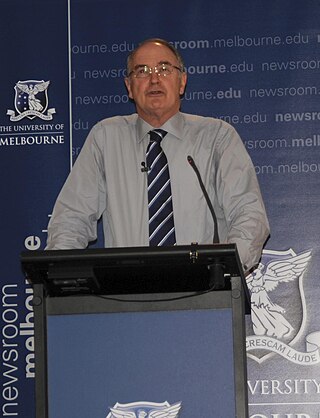Related Research Articles

Timothy Fridtjof Flannery is an Australian mammalogist, palaeontologist, environmentalist, conservationist, explorer, author, science communicator, activist and public scientist. He was awarded Australian of the Year in 2007 for his work and advocacy on environmental issues. He is the Geneva Graduate Institute’s Fondation Segré Distinguished Visiting Professor.

Alfred Cort Haddon, Sc.D., FRS, FRGS FRAI was an influential British anthropologist and ethnologist. Initially a biologist, who achieved his most notable fieldwork, with W.H.R. Rivers, C.G. Seligman and Sidney Ray on the Torres Strait Islands. He returned to Christ's College, Cambridge, where he had been an undergraduate, and effectively founded the School of Anthropology. Haddon was a major influence on the work of the American ethnologist Caroline Furness Jayne.

Roy Abraham Rappaport (1926–1997) was an American anthropologist known for his contributions to the anthropological study of ritual and to ecological anthropology.
Nicholas "Nick" Evans is an Australian linguist and a leading expert on endangered languages. He was born in Los Angeles, USA.

The fauna of New Guinea comprises a large number of species of mammals, reptiles, birds, fish, invertebrates and amphibians.
Andrew P. "Pete" Vayda was a Hungarian-born American anthropologist and ecologist who was a distinguished professor emeritus of anthropology and ecology at Rutgers University.

The northern broad-nosed bat is a species of the vespertilionid family of microbats. It can be found in northern Australia, Timor-Leste, and Papua New Guinea.

The yellow-bellied sheath-tailed bat, also known as the yellow-bellied sheathtail or yellow-bellied pouched bat, is a microbat species of the family Emballonuridae found extensively in Australia and less commonly in parts of Papua New Guinea.

The shining bronze cuckoo is a species of cuckoo in the family Cuculidae, found in Australia, Indonesia, New Caledonia, New Zealand, Papua New Guinea, Solomon Islands, and Vanuatu. It was previously also known as Chalcites lucidus.

The great flying fox, also known as the greater flying fox or Bismarck flying fox, is a species of megabat in the genus Pteropus, found throughout lowland areas of New Guinea and in the Bismarck Archipelago. Conflicting evidence suggests that its closest relative is either the spectacled flying fox or, jointly, the Pelew and insular flying foxes. Two subspecies are recognized. At up to 1.6 kg (3.5 lb) in weight, it is among the heaviest bats in the world and the largest bat in Melanesia. It is a gregarious animal which roosts with hundreds or thousands of individuals. In part due to its wide variation in color, it has many taxonomic synonyms, including Pteropus degener, Pteropus papuanus, and Pteropus sepikensis. It may forage during the day or night in search of fruit, including figs or fruits from the family Sapotaceae. It is considered a least-concern species by the IUCN, though its numbers have been negatively impacted by what appeared to be a disease, as well as by hunting for bushmeat that occurs across its range.

Ross Gregory Garnaut is an Australian economist, currently serving as a vice-chancellor's fellow and professorial fellow of economics at the University of Melbourne. He is the author of numerous publications in scholarly journals on international economics, public finance and economic development, particularly in relation to East Asia and the Southwest Pacific.

The continent of Australia, sometimes known in technical contexts by the names Sahul, Australia-New Guinea, Australinea, or Meganesia to distinguish it from the country of Australia, is located within the Southern and Eastern hemispheres. The continent includes mainland Australia, Tasmania, the island of New Guinea, the Aru Islands, the Ashmore and Cartier Islands, most of the Coral Sea Islands, and some other nearby islands. Situated in the geographical region of Oceania, Australia is the smallest of the seven traditional continents.
Jan Pouwer was a Dutch anthropologist with a thorough grounding in his profession in terms of fieldwork and theory. He studied Indology and Ethnology at Leiden University under the renowned Jan Petrus Benjamin de Josselin de Jong. He worked as a ‘government anthropologist’ and conducted extensive fieldwork in Netherlands New Guinea, 1951–62. He subsequently served as Professor of Anthropology at Amsterdam, Wellington (N.Z./Aotearoa) and Nijmegen Universities, 1962–87.
Lindy Lumsden is a principal research scientist with the Department of Environment, Land, Water and Planning, at the Arthur Rylah Institute for Environmental Research, in Melbourne, Australia.

Ron Vanderwal was an American-Australian Archaeologist who specialised in the prehistoric archaeology of the Pacific and New Guinea in particular. He worked at La Trobe University and the Museum of Victoria. He died on 19 July 2021.

Justin Olam is a Papua New Guinean professional rugby league footballer who plays for Wests Tigers in the NRL and Papua New Guinea at international level.
The New Guinea Exploration Expedition of 1885 was a scientific, collecting and anthropological expedition sent by the Geographical Society of Australasia to the Fly River region of Papua New Guinea. The expedition lasted for six months from 10th June to 3rd December 1885, of which five months were spent in New Guinea. They named and explored the Strickland River, and made vast biological discoveries, including numerous species.
Charles Dunford Rowley was an Australian public servant and academic.
Donald Bruce Foreman was an Australian botanist who worked on the Monimiaceae and Proteaceae of Australia. He also helped with the editing of selected Flora of Victoria and Flora of Australia Volumes.
Yolarnie Amepou is a zoologist and conservationist from Papua New Guinea. She is known for her work to protect the Papuan softshell turtle in Kikori. In 2017 she was a Youth Champion for the Sustainable Development Goals of the United Nations. She was also received a Pride of Papua New Guinea Award for Environment in 2015.
References
- ↑ "From business development to protection money: Landowners and the PNG LNG project". 3 July 2018.
- ↑ Dwyer, Peter D.; Minnegal, Monica (2006). "The Good, the Bad and the Ugly: Risk, Uncertainty and Decision-Making by Victorian Fishers". Journal of Political Ecology. 13: 1. doi: 10.2458/v13i1.21675 .
- ↑ "Profile: Peter D. Dwyer". ResearchGate .